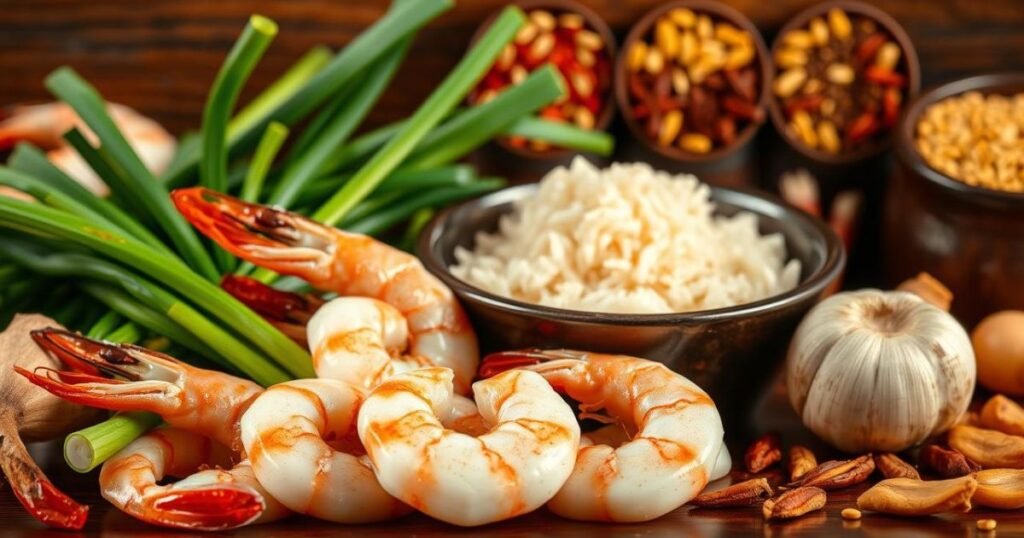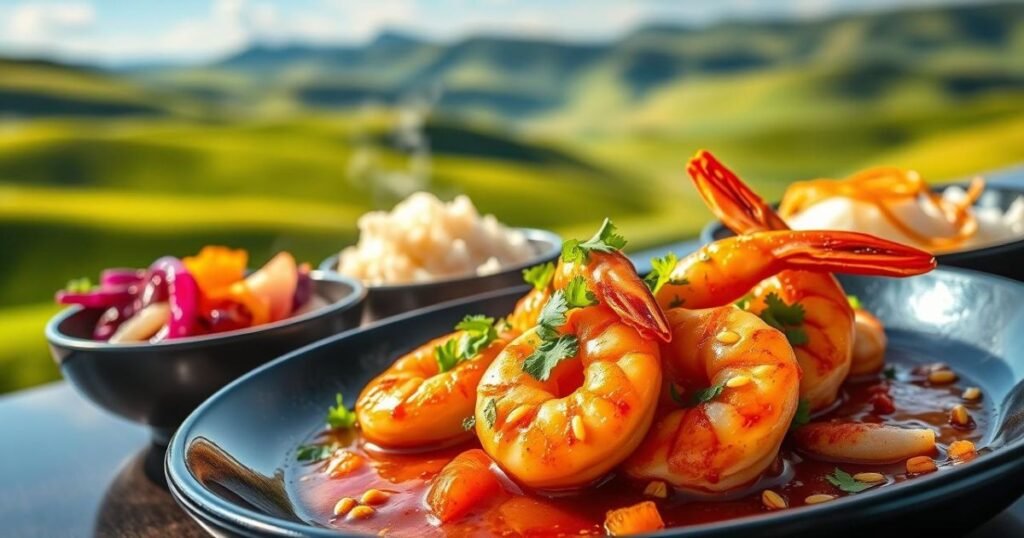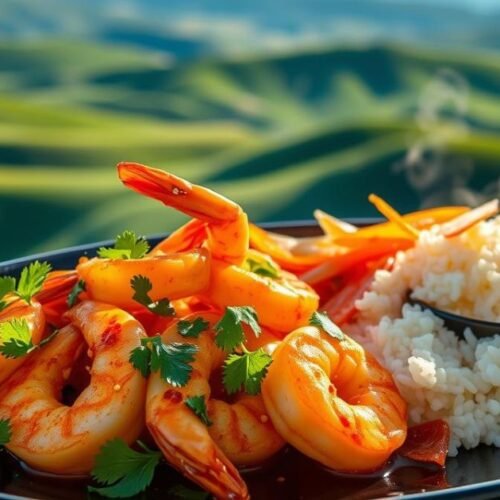Did you know Indo-Chinese cuisine has won the hearts of food lovers everywhere? Mongolian shrimp is a big hit. I’m excited to show you how to make this amazing dish. It’s all about bold flavors and easy cooking.
My love for trying new foods led me to Mongolian shrimp. It’s a mix of old Indo-Chinese ways and new cooking ideas. This dish is perfect for anyone, whether you’re experienced or just starting out.
This dish is simple yet full of flavor. I’ll guide you through making it, so you can make it just like a restaurant. Get ready to spice up your dinner with this recipe that’s sweet, savory, and a bit spicy.
Learning to make Mongolian shrimp is easy. You’ll learn how to pick the best shrimp and make the perfect sauce. Let’s start this tasty journey together!
Mongolian Shrimp: Origins and Culinary Tradition
Exploring Mongolian cuisine takes us on a journey beyond its origins. Mongolian shrimp and similar dishes are not from Mongolia. Instead, they come from Indo-Chinese cooking traditions.
The Evolution of Indo-Chinese Cuisine
Mongolian-style dishes started in Taiwan and mainland China. The stir-fry shrimp method is a mix of cooking styles. It changed how chefs cooked proteins, making flavors burst and textures exciting.
- Origins rooted in Taiwanese cooking styles
- Adaptation of traditional stir-fried techniques
- Blending of Chinese culinary influences
Why Mongolian Shrimp Became a Global Favorite
Its global popularity comes from its amazing taste. Sweet, savory, and spicy flavors mix in a way that people love. Quick to make and full of flavor, Mongolian shrimp is a hit in restaurants and homes.
Traditional vs Modern Preparation Methods
Old stir-fry methods used simple ingredients and careful cooking. Today, chefs add more flavors and use new tools. Home cooks can make restaurant-quality Mongolian shrimp with easy-to-find ingredients and modern kitchen gadgets.
- Traditional: Minimal ingredients, precise technique
- Modern: Diverse flavors, advanced cooking methods
- Accessible preparation for home chefs

Essential Ingredients for Perfect Mongolian Shrimp
Making a great garlic shrimp dish begins with picking the right ingredients. For authentic Mongolian shrimp, you need a mix of flavors that turn simple seafood into a work of art.
The main ingredient is large, fresh shrimp. Choose high-quality, deveined shrimp for the best taste and texture. The sauce is key, made from several important ingredients:
- Soy sauce: Adds depth and umami flavor
- Hoisin sauce: Brings sweet and tangy notes
- Sesame oil: Adds nutty, aromatic complexity
- Brown sugar: Balances and rounds out the flavors
- Minced garlic: Gives a strong, punchy taste
Now, let’s look at the sauce ingredients for Mongolian shrimp:
| Ingredient | Quantity | Purpose |
|---|---|---|
| Low sodium soy sauce | ¼ cup | Base flavor and saltiness |
| Hoisin sauce | ¼ cup | Sweet and tangy complexity |
| Sesame oil | 2 teaspoons | Nutty aromatic undertone |
| Brown sugar | 2 tablespoons | Sweetness and caramelization |
If you like it spicy, add red pepper flakes or chili garlic sauce. The right mix of these ingredients will make your Mongolian shrimp irresistible.

Mastering the Mongolian Sauce
Making the perfect Mongolian sauce is an art. It turns simple shrimp into a culinary masterpiece. The secret is balancing flavors and knowing the key ingredients.
To make an authentic Mongolian sauce, I aim for a sweet and savory mix. The base includes:
- Low-sodium soy sauce
- Brown sugar or honey
- Minced garlic
- Fresh ginger
- Rice vinegar
Balancing Sweet and Savory Flavors
The secret to a great sauce is its flavor balance. I use brown sugar for sweetness, which pairs well with salty soy sauce. For gluten-free options, tamari or coconut aminos are great substitutes.
Sauce Consistency and Texture Tips
Getting the sauce right is all about technique. I mix cornstarch to thicken, whisking it well to avoid lumps. The goal is a smooth, glossy sauce that sticks to the shrimp.
Making it Gluten-Free
Making a gluten-free Mongolian sauce is easy. Just swap soy sauce for tamari or coconut aminos. These alternatives give the same depth of flavor without gluten.
Pro tip: Always taste and adjust your sauce. The perfect Mongolian sauce balances sweet, salty, and tangy. It makes your shrimp dish taste like it’s from a restaurant.
Step-by-Step Cooking Technique
Cooking perfect Mongolian shrimp needs careful preparation and precise technique. Before starting, make sure to peel and devein the shrimp well. Pat them dry with paper towels to remove excess moisture. This step is key for a beautiful sear.
Here’s my recommended cooking process:
- Prepare the shrimp by removing shells and deveining
- Pat the shrimp dry completely
- Heat your skillet to medium-high heat
- Add the shrimp in a single layer, avoiding overcrowding
- Cook for approximately 2 minutes per side
Timing is everything when cooking shrimp. Use medium-high heat for a crisp exterior and tender interior. Cook in batches to prevent steaming and ensure perfect caramelization. Cooking time should be about 4 minutes for medium-sized shrimp.
Pro tip: Watch for visual cues. Cooked shrimp will turn pink and curl slightly, showing they’re ready. Avoid overcooking to prevent tough and rubbery shrimp.
Enhancing Your Mongolian Shrimp with Perfect Pairings
Creating the perfect Mongolian shrimp dish is more than just cooking the main ingredient. I’ll show you how to pick the right sides, garnish, and try new sauce variations. These tips will turn your meal into a true masterpiece.
Complementary Side Dishes
Choosing the right sides can make your meal even better. Here are some great options:
- Steamed jasmine rice – a classic that soaks up the sauce
- Stir-fried vegetables with bell pepper for crunch and color
- Chow mein noodles for a heartier meal
- Asian-inspired salad with fresh green onions and sesame seeds
Garnishing for Presentation
A dish looks great with the right garnish. Sprinkle green onions and sesame seeds over your shrimp. The white and black look is beautiful and adds flavor.
Sauce Variations and Adaptations
Try new sauce variations to change up your Mongolian shrimp. Here are some ideas:
| Sauce Variation | Key Ingredients | Flavor Profile |
|---|---|---|
| Spicy Version | Red pepper flakes, avocado oil | Hot and tangy |
| Sweet Version | Additional brown sugar | Caramelized sweetness |
| Citrus Twist | Orange zest, rice vinegar | Bright and refreshing |
Remember, the secret to a great Mongolian shrimp dish is balancing flavors and having fun with your cooking!

Conclusion
Exploring Asian shrimp cuisine has opened my eyes to the Mongolian shrimp recipe’s wonders. It started as a fun cooking journey and turned into a tasty adventure at home. This stir-fry shrimp dish is more than food; it’s a doorway to Indo-Chinese flavors.
Learning this recipe means being creative and flexible. It’s perfect for both new cooks and seasoned chefs. The dish’s charm comes from its easy nature and ability to change. You can tweak spices, try different proteins, or adjust ingredients for special diets.
Cooking is a way to share love and connect with others. Making this Mongolian shrimp recipe is more than cooking a meal. It’s about creating a special moment that brings people closer. The flavors, sounds, and smells make dinner unforgettable.
I invite you to cook with confidence. Use what you’ve learned, trust your taste, and enjoy making something tasty. Your journey with Asian shrimp is just starting, and the possibilities are endless.
FAQ
What makes Mongolian shrimp different from other shrimp dishes?
Mongolian shrimp features a unique Indo-Chinese blend with a bold, sweet, and spicy sauce made from soy sauce, hoisin sauce, brown sugar, garlic, and ginger. This mix creates a flavor that’s distinct from other shrimp dishes.
Is Mongolian shrimp actually from Mongolia?
No, Mongolian shrimp is a fusion dish originating from Taiwan and mainland China. It’s inspired by Mongolian beef but uses seafood instead, representing Indo-Chinese cuisine rather than traditional Mongolian cooking.
How do I prevent my shrimp from becoming tough when cooking?
To keep shrimp tender, cook them on medium-high heat without overcooking. Pat them dry before cooking, and stir-fry in batches to avoid overcrowding. Cook them for 2-3 minutes until they turn pink and opaque.
Can I make this recipe gluten-free?
Yes, you can make Mongolian shrimp gluten-free by using tamari or coconut aminos in place of soy sauce. Be sure to use gluten-free hoisin sauce or an alternative. Shrimp, garlic, ginger, and brown sugar are naturally gluten-free.
What are the best side dishes to serve with Mongolian shrimp?
Mongolian shrimp pairs well with steamed jasmine rice, fried rice, chow mein noodles, or stir-fried bell peppers. An Asian-inspired salad also complements the dish perfectly.
How spicy is Mongolian shrimp?
Mongolian shrimp can be adjusted to your preferred spice level. The base recipe is mild, but you can add red pepper flakes or sriracha for more heat. For less spice, simply omit the spicy ingredients.
What type of shrimp works best for this recipe?
Use large shrimp (16-20 count) that are peeled and deveined. Whether fresh or frozen, ensure the shrimp are thawed and patted dry before cooking to get a good sear and avoid excess moisture.
Can I make this recipe ahead of time?
While best served fresh, you can make the sauce ahead of time and store it in the fridge for up to 3 days. Cook the shrimp just before serving to ensure they stay tender and don’t overcook.

Mongolian Shrimp Recipe
Ingredients
- Main Ingredients:
- 1 lb large shrimp peeled and deveined
- Sauce Ingredients:
- ¼ cup low sodium soy sauce
- ¼ cup hoisin sauce
- 2 teaspoons sesame oil
- 2 tablespoons brown sugar
- 2 cloves garlic minced
- 1 teaspoon fresh ginger grated
- 1 tablespoon rice vinegar
- ½ teaspoon red pepper flakes optional, for heat
- 1 teaspoon cornstarch for thickening
- Garnishes Optional:
- 2 tablespoons green onions chopped
- 1 teaspoon sesame seeds
Instructions
- Prepare the Shrimp: Remove shells, devein, and pat the shrimp dry completely with a paper towel.
- Mix the Sauce: In a bowl, whisk together soy sauce, hoisin sauce, sesame oil, brown sugar, minced garlic, ginger, rice vinegar, and red pepper flakes (if using).
- Thicken the Sauce: In a separate small bowl, mix cornstarch with 1 tablespoon of water to form a slurry. Set aside.
- Cook the Shrimp: Heat a large skillet or wok over medium-high heat. Add a drizzle of sesame oil.
- Sear the Shrimp: Add the shrimp in a single layer, ensuring they are not overcrowded. Cook for about 2 minutes on one side, then flip and cook for another 2 minutes until they turn pink and slightly curled. Remove from the pan and set aside.
- Cook the Sauce: In the same pan, pour in the sauce mixture and bring it to a gentle simmer. Stir in the cornstarch slurry and mix well until the sauce thickens (about 1 minute).
- Combine Everything: Return the shrimp to the pan, tossing to coat them evenly in the sauce. Cook for another minute until heated through.
- Garnish & Serve: Remove from heat, garnish with chopped green onions and sesame seeds. Serve hot with steamed jasmine rice or noodles.
Notes
- For gluten-free options: Use tamari or coconut aminos instead of soy sauce and ensure hoisin sauce is gluten-free.
- Adjusting Spice Levels: Add more red pepper flakes or sriracha for extra heat, or omit them for a milder version.
- Best Side Dishes: Pairs well with jasmine rice, chow mein noodles, or stir-fried vegetables like bell peppers and bok choy.
- Storage & Reheating: Store leftovers in an airtight container in the fridge for up to 3 days. Reheat gently in a pan to avoid overcooking the shrimp.

